The walk out
5.05.01. To the south Makalu base camp
JC and I said farewell to everyone, and left at 12:30. We reached the lower Makalu base camp (4700) at 5pm. Spectacular view of Makalu from there.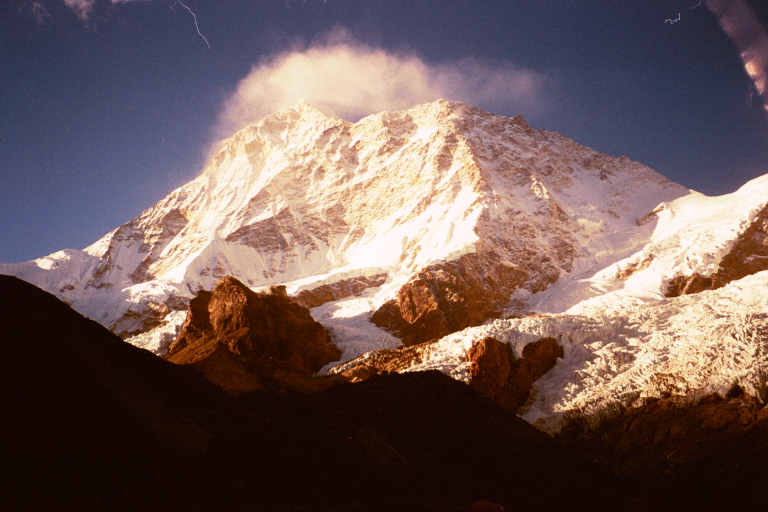
Guy and Ang Tshering arranged two porters to carry my gear out for me. They were very friendly and helpful --- one (a Sherpa) had been working for us (going down to Nehe Kharka for fresh vegetables), and the other (a Rai) for the Chileans.
An indication of my deterioration: on the way in, I had climbed from the south Makalu base camp to our base camp (4700m to 5700m) in 5 hours and 20 minutes, but it had taken me almost as long, 4 hours and 30 minutes, to descend. After 23 days of Guy's regimen, I was slower at high altitude than when I started.
6.05.01. To Mumbuk
Had a good night's sleep.JC, the 2 porters and I left at 6:35am. In the morning, the weather was perfect. I stopped every hour for a rest and a drink (we didn't bring a stove, so hydration was difficult). The walk in the morning was one of the most beautiful of my life.
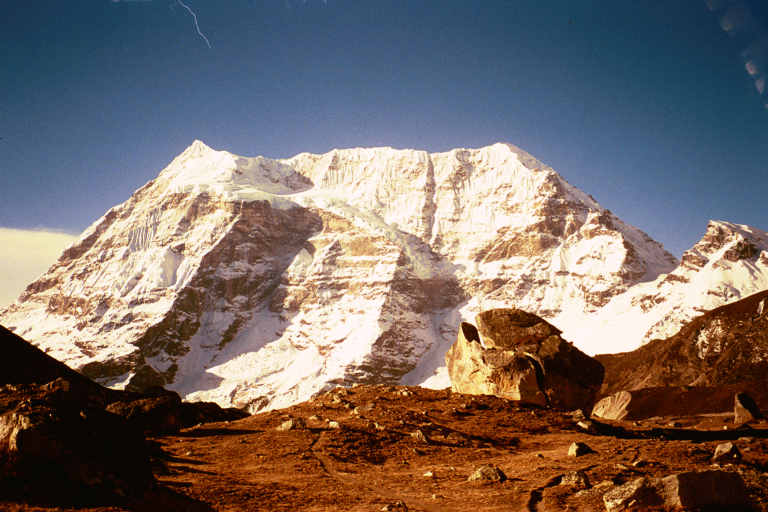
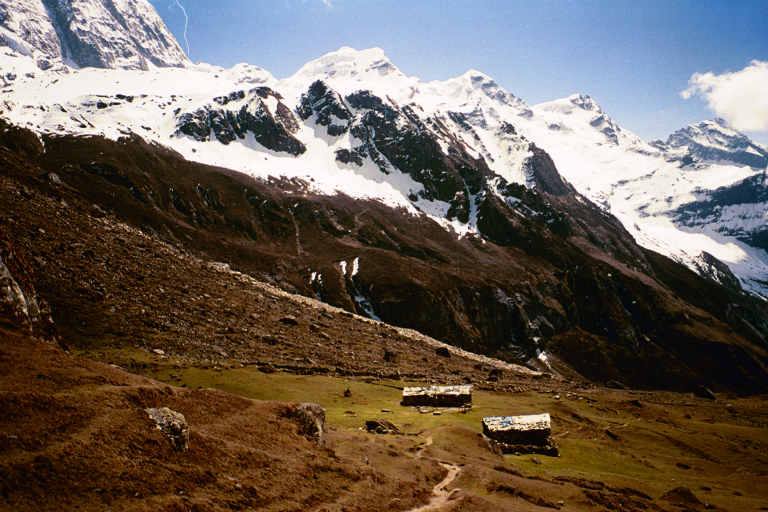
Later it clouded over and became foggy.
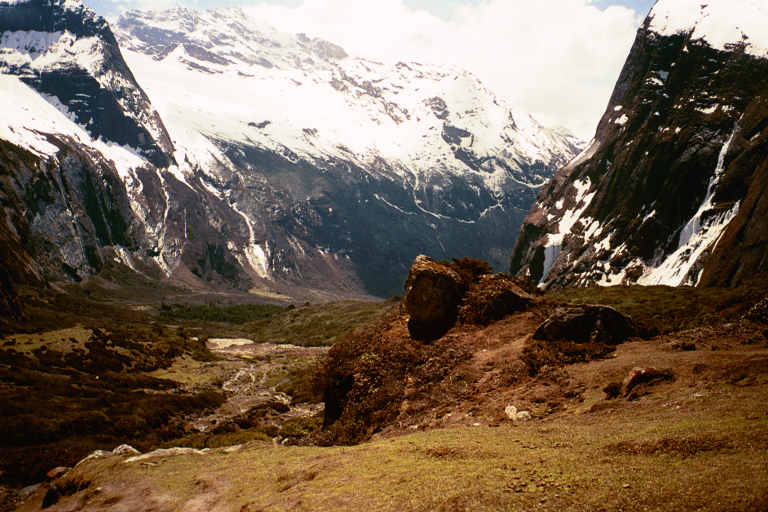
At Yak Kharka the couple were working in their vegetable garden, so I didn't stop for lunch as I intended. Just before the bridge, I met a group of Nepalese who looked as though they may have been returning to their summer/monsoon home.
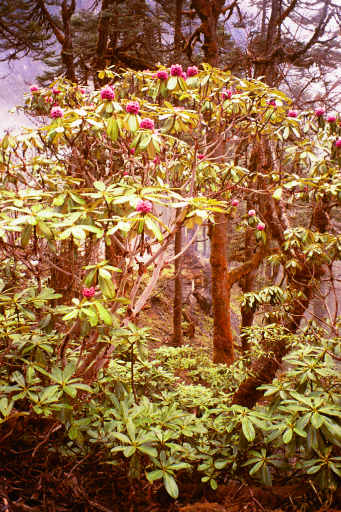
I met a group of 4 trekkers not long before Mumbuk, one of whom told me "there is some snow on Shipton Pass but it is easy to avoid it". Just before Mumbuk, met a large group of porters going into base camp with almost empty baskets. Arrived at Mumbuk at 5:20pm, but I had taken my time and so was not very tired. Began raining and porters hadn't arrived, so I sheltered in JC's tent. The Sherpa arrived with my sleeping bag about 7pm; the Rai didn't arrive with my tent until 8:20pm --- he had been drinking rukshi with his friends (the large group of porters).
7.05.01. To Tashigaon
Not raining, but overcaste in the morning ---- it had rained quite a bit in the night. Left at 6:35. Went slowly at the start with plenty of rests, and felt tired. The rhododendrons were beautiful --- a hill side of pink flowers, then red flowers higher up, and finally yellow.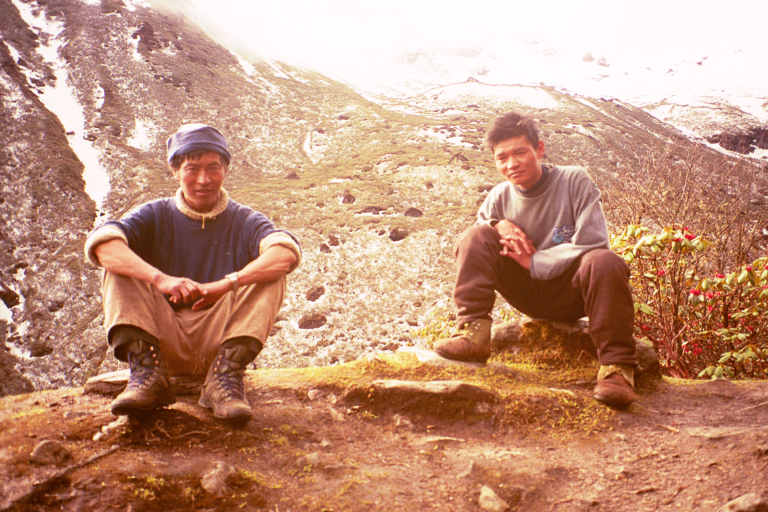
There was a lot of soggy snow, despite what the trekker had told me. Eventually I speeded up, especially when light rain began before I reached Shipton Pass. Slogged on through the snow. Reached Kaungma in about 7 hours, about 5 of which were spent on soggy snow in my light walking shoes. Stopped for tea and biscuits. Left 2:30; down to Tashigaon at 5:20. Rain heavy at times during descent. Met JC in first lodge.
Four leeches had attached themselves to me --- one I removed immediately; the second a kid saw and pulled off me after it had gorged itself; the remaining two had already dropped off leaving a wound. They were the first leeches I'd seen. I didn't find them as disgusting as I feared --- given how overloaded my blood was with red blood cells, losing a little blood would probably do me good.
The Rai porter had to return to base camp with a load of vegetables for the Chileans, so I asked lodge owner to find me a replacement porter to Tumlingtar.
8.05.01. To Num
I slept well in the lodge, but JC complained of snoring, especially by my Sherpa porter and the third occupant of our dorm room.Couldn't find porter to Tumlingtar --- the Sherpas of Tashgaon don't like to work as porters in the hot areas below. Finally, I found one porter who was willing to carry a load to Sedua for me (300R).
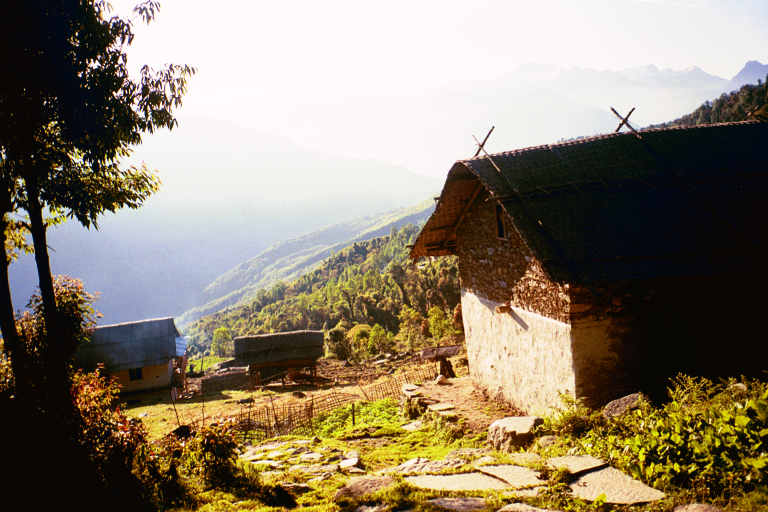
Walked down to Sedua in about 2 3/4 hours. A small black snake slithered across the trail in front of me. After I arrived in Sedua, I had some trouble finding JC and my Tashigaon porter. The first people I spoke to said I wouldn't be able to find a porter to go to Num today, but I did find one (by accidentally offering 1500R ($20) to Tumlingtar whereas standard pay is 1200R). Then my Sherpa porter hobbled in with a sprained ankle, so I needed a second porter. I paid my Sherpa 500R, and he set off to hobble back to his village, 2 days distant. Found second porter --- I think I hired two of the local juvenile delinquents, but they were happy (and good) porters. They had lunch and packed for the trip to Tumlingtar --- one brought nothing but a water bottle (no clothes or money). Left 11am, and reached Num at 4pm. On way saw a young man who had just shot at a bird with a large shotgun. He gave me a dirty look, but I don't think he was a Maoist. It was very tiring climbing the huge number of stone steps from the river to Num in the heat. Had beer. Stayed at Makalu Lodge. Lodge man thought I was 80 years old! (O.K., so may be by now I felt 80 years old, but I don't think I looked it). JC had eaten there and gone onto the next village (Mure). [He was unable to find a place to stay, or even someone to give him a cup of tea, and spent an uncomfortable night in his tent in the rain.] [Unlike me, JC had left his gear at base camp, and so would have to wait in Kathmandu until the rest of the party returned.]
9.05.01 To Mani Banjang
Rain was very heavy during the night and in the morning. Bought some plastic for the porters and left at 7am. Fortunately, the rain soon became light, or stopped altogether. Apart from a few very heavy showers, that's how it remained all day. Views early were interesting with patches of fog, but later I was mainly in dense fog.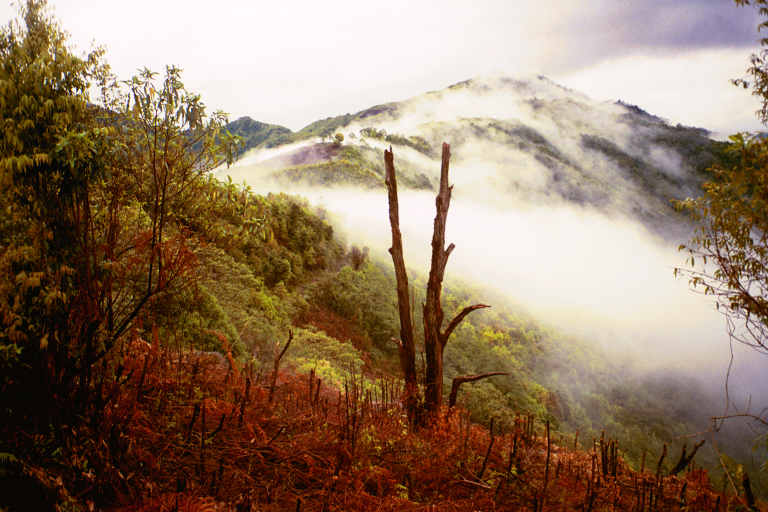
Stopped for lunch at Chichiya, and left at about 1pm. Saw many frogs on the trail. The porters and I descended in heavy rain to Mani Bhanjang, where I stayed in the Everest hotel --- pleasant owner.
10.05.01. To Tumlingtar and Kathmandu
Rain stopped during the night. Left 6:30am in good weather for Tumlingtar. Got down at 9am and found JC staying in the least reputable hotel (the one we had stayed in on the way up). He told me of his travels through the storms of yesterday as if I had not also travelled through them. He had met two army patrols, one of which had two prisoners.He had confirmed that we had reservations on the flight to Kathmandu today, but, because of some mix-up, he hadn't been given the tickets that Wilderness Experience (Adventure Consultant's agent) had sent to the hotel 4 days earlier, and we had to pay the $72 fare. Flew to Kathmandu, and reached Hotel Garuda, where (amazingly!) I was able to change my reservation and get on tomorrow's flight to Bangkok.
11.05.01. To Bangkok
Called NorthWest Airlines in Kathmandu. Am wait-listed for 12th and confirmed for 13th. Flew to Bangkok. NW office closed. Telephoned after 9pm, and found I could go standby on the 12th and, since the plane was far from full, would certainly get on.12.05.01. To Ann Arbor.
Left Bangkok at 6am, and was back in Detroit at 1:30pm. Home by 2:40pm.Postscript
After we left, the remaining six climbers set off for the summit. Only Guy, Takashi, and Rob planning to use oxygen above Camp 4. Bryan turned back before Camp 4. Here is Rob's telephone report of the summit day (12.05.01) (slightly edited).14.05.01 Monday, 11:30 a.m.
Good morning from Makalu Base Camp; it is about 11:30. We have got some high cloud cover, I know there are a few people trying to summit today.
This is Robert Stephens by the way. Hamish called yesterday, we were pretty wiped out from our summit attempt, so I know he filled you in a little bit on what happened.
I can go over a few things, and update you on what's happening. Takashi did arrive in to camp about 10 minutes ago; he was suffering from severe snow blindness and had to stay up there an extra day.
Guy came down yesterday, and he is in good shape, as did Dorje and congratulations those three and our team for getting to the summit.
We had seven of us starting out on that day, and as it played out we had two sherpas and Guy, Bruce, Willie, Takashi and myself.
On summmit day (12.05.01) we rose about 1 a.m. and started brewing and getting our gear on. We left camp around 3 a.m. Beautiful morning - about 5 a.m. the sun started to rise, and that was when we lost our first sherpa. He turned around mainly because of cold toes. Unfortunately he had all the fixed ropes for us with him.
As it turns out, that was pretty much my demise, not having those fixed ropes up higher on the mountain.
Let's see, a little bit later - around 7,900 meters, Bruce was also feeling the effects of the cold, and it wasn't his day so he turned around. At around 8,000 meters is pretty much where I decided the safety level and what was going to happen later on in the day - I knew the climbing was going to get more technical and more difficult, obviously, the higher we went, and I just felt without the fixed ropes it was not going to work out for me, so I decided to turn around at that point.
Willie kept going for a while - he turned around around 8,100 meters. About 150 meters above him, Takashi was out in front; he was extremely strong and doing well that day. He triggered an avalance and figured he went down about 50 meters.
That was pretty scary for him. Luckily his good mountaineering instincts - Takashi, quite the seasoned veteran - was able to arrest himself with his ice axe and keep on going. My hat's off to him. At any rate, that was enough for Wille so he turned around at that point.
I got back down to Camp 4 and Bruce was there recovering, and we decided to take off and try to get down to Base Camp. It was around 9 or 10 in the morning, so we packed up our gear there and went down to Camp 3, picked up more of our gear. I took off a little before Bruce.
It was a tough day getting down. There were about 60 mile-per-hour winds right there at the top of that couloir and we felt like we were in kind of a time warp scene in a movie, snow just whipping by your feet.
Anyway, we got down the couloir and, second rope down it was buried probably a foot-and-half - we couldn't even find it, so we had to downclimb without rope for a while, and that was a bit stressful.
A little further down into the couloir we were able to get some ropes and safely able to get down into it and into Camp 2. We found two out of three tents completely destroyed from the wind and snow - completely buried. It was quite a scene, so we dug those out and got the rest of our gear out of there and got back down into Base Camp around 6 p.m.
It was a very stressful day. Still having a lot of emotions about it, and dealing with my own personal disappointment, but I will get over it. It is only a mountain.
We are all very proud that Guy and Takashi and Lhakpa Dorje made it to the summit around 2:30 or 3 p.m. They got down to Camp 4 around 6 or a little bit later.
I know if I had been with them; I was feeling strong, had been on the oxygen and there wasn't a problem health-wise, just the comfort level with the safety factor and going the distance would have been very rough for me and slow going. I am certainly not in their league, and I know my limitations.
Lhakpa Dorje Sherpa was the first person to climb Makalu twice, and Guy was only the second New Zealander to climb it (Rob Hall climbed it in 1995; two expeditions led by Ed. Hillary and one led by Peter Hillary had been unsuccessful). With the exception of the American expedition on the southwest ridge and Spanish expedition on the standard route, most expeditions have put at least a couple of members on the summit. As of 16.05.01, there are two climbers missing on the mountain, presumed dead.
Postscript 25.08.01.
According to EverestNews.com, only one climber went missing on Makalu this spring.After I returned I did a some research on the effects of high altitude (courtesy of the UMich Medical Library). The literature is vast --- a surprising number of medically trained people have been willing to suffer the hardships and dangers of high altitude climbing to increase scientific knowledge on the effects of high altitude on human physiology.
A major factor in high-altitude deterioration is weight loss. Under
ideal circumstances, 75% of any weight loss is fat, but at high
altitudes (above 5400m) only 25% of weight loss is fat. Dramatic loss of
muscle has been observed. To prevent weight loss, one should eat as much
high-carbohydrate food as possible. At 5800m, switching from a high-fat
diet to a high-carbohydrate diet resulted in a dramatic increase in
arterial oxygen saturation, and in a corresponding improvement in
athletic performance. A low fat diet is recommended because fat is not
absorbed (i.e., it ends up in faeces) and hinders the absorption of
sugars and amino acids.
(Ward, High Altitude Medicine and Physiology, 1995, 3.8.2,
13.8).
The food available to us above base camp (i.e., above 5700m), by my count, consisted of about 600kcal/day of high carbohydrate food (2 small packets of cereal; 2 muesli bars). The rest was either a mixture (e.g., prepared dinners in a bag) or was high-fat (cheese, chocolate coated peanuts, etc.). I lost 15 lbs during the trip, about double what I would expect on a (more) energetic trekking trip of the same length. I was the heaviest of the group. Probably the second heaviest was Bryan and he also suffered a surprising deterioration.
That you should eat only high-carbohydrate low-fat food at high altitudes has been common knowledge among climbers for many years, or at least I thought it was. When I asked Guy why we had so little high carbohydrate food, he said that he brought the food that people had liked to eat, and appeared to be unaware of the research.
If I attempt an 8000m peak again next year, I will be eating dal bhaat (like the sherpas) and granola bars (as on all my other climbs), and I will be following the schedule my body dictates.
The Adventure Consultants site is www.adventure.co.nz
All of Rob's reports can be found at www.modbee.com